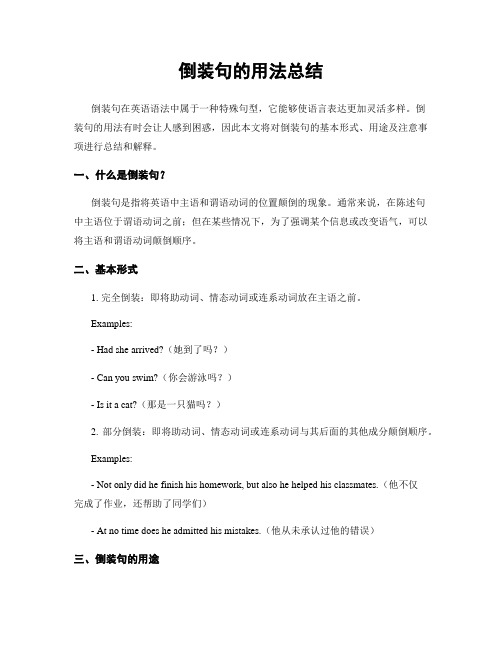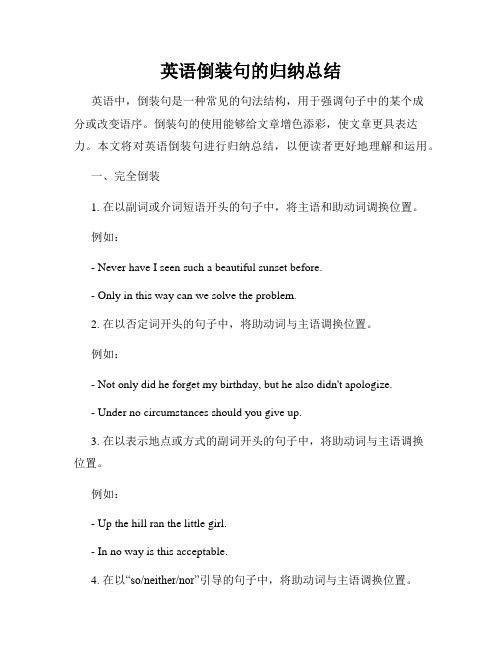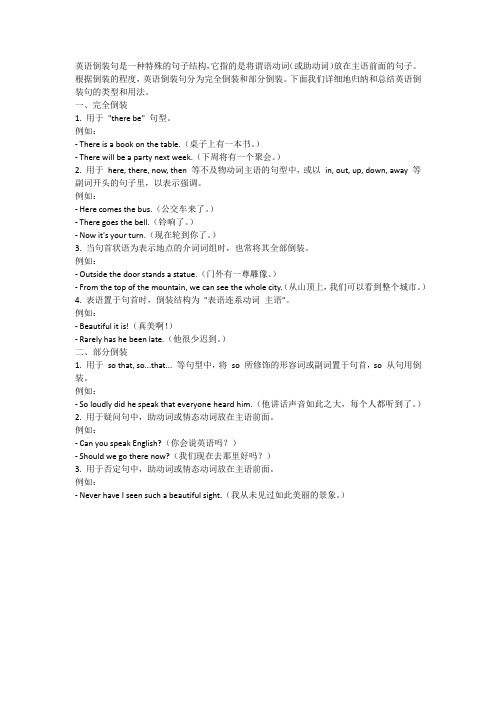英语倒装句用法小结
- 格式:doc
- 大小:21.00 KB
- 文档页数:5

倒装句的用法总结倒装句在英语语法中属于一种特殊句型,它能够使语言表达更加灵活多样。
倒装句的用法有时会让人感到困惑,因此本文将对倒装句的基本形式、用途及注意事项进行总结和解释。
一、什么是倒装句?倒装句是指将英语中主语和谓语动词的位置颠倒的现象。
通常来说,在陈述句中主语位于谓语动词之前;但在某些情况下,为了强调某个信息或改变语气,可以将主语和谓语动词颠倒顺序。
二、基本形式1. 完全倒装:即将助动词、情态动词或连系动词放在主语之前。
Examples:- Had she arrived?(她到了吗?)- Can you swim?(你会游泳吗?)- Is it a cat?(那是一只猫吗?)2. 部分倒装:即将助动词、情态动词或连系动词与其后面的其他成分颠倒顺序。
Examples:- Not only did he finish his homework, but also he helped his classmates.(他不仅完成了作业,还帮助了同学们)- At no time does he admitted his mistakes.(他从未承认过他的错误)三、倒装句的用途1. 当以否定词开头表达“部分否定”的意思时,常常使用完全倒装。
Example:- Never have I seen such a beautiful sunset.(我从未见过如此美丽的日落)2. 在虚拟条件句中,通常采用部分倒装。
Example:- Should you need any assistance, please let me know.(如果你需要任何帮助,请告诉我)3. 在介词短语置于句首时,为了避免重复或强调信息,可以使用完全或部分倒装。
Examples:- Off the table fell a plate.(桌子上掉下了一只盘子)- Into the room walked a toddler and her mother.(一个蹒跚学步的小孩和她的妈妈走进了房间)四、注意事项1. 只有助动词、情态动词和连系动词才能发生倒装。

英语中,例装句是一个非常重要的知识点,在各类考试中都会有例装句相关知识的出现,因此,有必要把例装句学好。
英语中的例装句有两种形式,一种是完全倒装,另一种是部分倒装。
一、完全倒装结构句式1. Here/There/Now/Then/Thus+不及物动词+名词There goes the bell. Let's go back to the classroom. 铃响了,我们回教室吧。
Here comes the bus. Let’s hurry up! 公共汽车来了,我们快点吧!句式2:Out/In/Up/Down/Away/Off/Back/Over+不及物动词+名词Out rushed the students.同学们冲出了教室。
Away ran the boys. 男孩子们跑走了。
句式3:介词短语+不及物动词+主语On the wall hang a big clock. 墙上挂着一个在钟。
注意,介词短语一般为表地点。
句式4:表语+系动词+主语Present at the meeting were directors of different departments. 出席会议的各部门的主任。
注:表语可以是:介词短语、形容词、过去分词、现在分词句式5:Such+be+主语Such are the facts. We have to face them. 这些就是事实,我们必须面对。
二. 部分倒装结构句式1:某些以so,nor,neither开头的句子。
一般表示重复前句的部分内容,意思是“也”,此时要部分倒装。
Tom went swimming yesterday, and so did I. 汤姆昨天去游泳了,我也去了。
注意,例装部分的谓语应与前句的谓语在时态/形式上一致。
句式2:表示否定意义的连词、副词或短语置于句首时。
By no means shall I forget you. 我决不会忘记你的。

英语倒装句的归纳总结英语中,倒装句是一种常见的句法结构,用于强调句子中的某个成分或改变语序。
倒装句的使用能够给文章增色添彩,使文章更具表达力。
本文将对英语倒装句进行归纳总结,以便读者更好地理解和运用。
一、完全倒装1. 在以副词或介词短语开头的句子中,将主语和助动词调换位置。
例如:- Never have I seen such a beautiful sunset before.- Only in this way can we solve the problem.2. 在以否定词开头的句子中,将助动词与主语调换位置。
例如:- Not only did he forget my birthday, but he also didn't apologize.- Under no circumstances should you give up.3. 在以表示地点或方式的副词开头的句子中,将助动词与主语调换位置。
例如:- Up the hill ran the little girl.- In no way is this acceptable.4. 在以“so/neither/nor”引导的句子中,将助动词与主语调换位置。
例如:- So beautiful is the scenery that it takes my breath away.- Neither have I finished my homework, nor has my brother.二、部分倒装1. 在以“if/whether”引导的条件句中。
例如:- If you work hard, you will achieve your goals.- Whether he comes or not, we will have the party.2. 在以“so that/such that”引导的结果状语从句中。
例如:- He spoke so quickly that I couldn't catch up with him.- The problem is such that it requires a professional to solve it.3. 在以“as/though”引导的方式状语从句中。

英语倒装句是一种特殊的句子结构,它指的是将谓语动词(或助动词)放在主语前面的句子。
根据倒装的程度,英语倒装句分为完全倒装和部分倒装。
下面我们详细地归纳和总结英语倒装句的类型和用法。
一、完全倒装1. 用于"there be" 句型。
例如:- There is a book on the table.(桌子上有一本书。
)- There will be a party next week.(下周将有一个聚会。
)2. 用于here, there, now, then 等不及物动词主语的句型中,或以in, out, up, down, away 等副词开头的句子里,以表示强调。
例如:- Here comes the bus.(公交车来了。
)- There goes the bell.(铃响了。
)- Now it's your turn.(现在轮到你了。
)3. 当句首状语为表示地点的介词词组时,也常将其全部倒装。
例如:- Outside the door stands a statue.(门外有一尊雕像。
)- From the top of the mountain, we can see the whole city.(从山顶上,我们可以看到整个城市。
)4. 表语置于句首时,倒装结构为"表语连系动词主语"。
例如:- Beautiful it is!(真美啊!)- Rarely has he been late.(他很少迟到。
)二、部分倒装1. 用于so that, so...that... 等句型中,将so 所修饰的形容词或副词置于句首,so 从句用倒装。
例如:- So loudly did he speak that everyone heard him.(他讲话声音如此之大,每个人都听到了。
)2. 用于疑问句中,助动词或情态动词放在主语前面。
例如:- Can you speak English?(你会说英语吗?)- Should we go there now?(我们现在去那里好吗?)3. 用于否定句中,助动词或情态动词放在主语前面。

英语倒装句语法总结英语倒装句是一种句法结构,它通过将主语和助动词的位置颠倒,以实现强调、表示条件或修饰的功能。
倒装句在英语中常常用于口语和书面语中,给文本增加了一定的变化和兴趣。
在本文中,将对英语倒装句进行详细总结,以便读者更好地理解和运用这一语法结构。
一、完全倒装句在完全倒装句中,整个谓语动词位于主语之前,这种倒装句一般用于以下几种情况:1. 当以“here”、“there”、“now”或表示地点、时间的副词开头的句子时,倒装句常被使用。
例如:Here comes the bus.There goes John.Now is the time for action.2. 在以表示否定意义的副词或短语开头的句子中,倒装句也常见。
例如:Never have I seen such a beautiful sunset.Not only is she talented, but she is also kind-hearted.3. 在以“only”开头修饰状语从句的句子中,倒装句也经常使用。
例如:Only when you face your fears can you overcome them.Only in this way can the problem be solved.二、部分倒装句部分倒装句中,只将助动词或情态动词放在主语之前,而将主语与谓语动词的位置维持原状。
部分倒装句常用于以下几种情况:1. 当以否定副词“never”、“seldom”或“rarely”开头时,部分倒装句可以被采用。
例如:Never have I been so happy.Seldom does he complain about anything.2. 在以“so”或“such”引导的句子中,为了表达强调,可以使用部分倒装句。
例如:So tired was she that she fell asleep on the couch.Such is the power of love that it can conquer all obstacles.3. 在以“not”开头的句子中,为了增强否定的语气,常常使用部分倒装句。

英语倒装句用法经典总结英语倒装句用法经典总结1. 否定副词位于句首时的倒装在正式文体中,never, seldom, rarely, little, hardly, scarcely, no sooner, no longer, nowhere 等含有否定意义的副词若位于句首,则其后要用部分倒装:I shall never forgive him. / Never shall I forgive him. 我永远不会宽恕他。
He seldom goes out for dinner. / Seldom does he go out for dinner. 他很少出去吃饭。
She hardly has time to listen to music. / Hardly does she have time to listen to music. 她几乎没时间听音乐。
He little realizes how important this meeting is. / Little does he realize how important this meeting is. 他不甚明白这个会议的重要性。
We had no sooner reached the airport than the plane took off. / No sooner had we reached the airport than the plane took off. 我们刚到机场,飞机就起飞了。
【注意】(1) 对于not…until句型,当not until…位于句首时,其后的主句要用倒装语序:He didn’t leave the room until the rain stopped. / Not until the rain stopped did he leave the room. 雨停了之后他才离开这房间。
倒装句的用法归纳总结一、倒装句的基本概念与形式(200字左右)倒装句作为英语语法中的重要部分,主要是指在语序上的改变。
通常,在陈述句中,主语位于谓语动词之前,但在倒装句中,这种顺序被逆转了。
1. 完全倒装:完全倒装发生在助动词、情态动词、系动词或者是一些特殊动词后面。
例如:He can not only play the guitar, but also sing beautifully.(他不仅会弹吉他,而且唱得很漂亮。
)Not until the game was over did I realize I had made a mistake.(比赛结束后我才意识到我犯了个错误。
)2. 部分倒装:当句子以表示否定、副词或者介词短语开头时,可以将谓语动词与主语的位置对调。
例如:Never have I seen such a beautiful sunrise before.(我从未见过如此美丽的日出。
)In no way will she agree to your proposal.(她绝不会同意你的提议。
)二、不同情况下的倒装句用法(600字左右)倒装句的使用灵活多样,根据具体情况和需要可以应用于不同场景。
1. 逆置在表示否定意义的副词或短语之前。
例如:Hardly had she arrived home when it started to rain.(她一到家就开始下雨。
)Under no circumstances should you disturb the birds' nests.(在任何情况下都不应该打扰鸟巢。
)2. 用于强调句子中的某一成分。
例如:It is in the library that students can find a quiet place to study.(只有在图书馆里学生才能找到一个安静的地方学习。
)Only after years of practice can one master a musical instrument perfectly.(只有经过多年的练习,一个人才能完美地掌握一种乐器。
倒装句用法总结第1篇(1)only所修饰的副词/介词短语/状语从句位于句首时(但only修饰主语位于句首时不倒装);(2) never,hardly,seldom,scarcely,little,not…until,at no time,not once,not,no,in notime等否定意义的词位于句首时;(3) so…that中so或such…that中such位于句首时.方法:以上三种情况都倒装主句.(4)形容词/名词/动名词+as/though的让步状语从句中(although引导的让步状语从句不能倒装,though也可以不倒装);方法:倒装从句.(5) not only…but also连接并列分句时(连接主语时不倒装);方法:前倒后不倒.(6) neither…nor连接并列分句时(连接主语时不倒装);方法:前后都倒.(7)so位于句首表示前句的内容也同样适用于后一个人或物时(只能是肯定句,且前后两句主语不同);方法:so+助动词+主语.(8)neither/nor用于句首,表示前句的否定内容也适用于后一句的人/物时(只能用于否定句,且前后两句主语不同);方法:neither/nor+助动词+主语.(9) 表示祝愿的祈使句中:方法:副词+谓语+主语,may+主语+谓语.(10)在虚拟语气中,如果if条件从句有系动词were或助动词should/had,可以把其置于句首,同时省去if.●典型考题(答案分别为BBA)1. So difficult _________ it to work out the problem that I decided to ask Tom for advice.A. I did findB. did I findC. I have foundD. have I found2. _________ about wild plants that they decided to make a trip to Madagascar for further research.A. so curious the couple wasB. So curious were the coupleC. How curious the couple wereD. The couple was such curious3. —It’s burning hot today, isn’t it?—Yes. _________ yesterday.A. So was itB. So it wasC. So it isD. So is it特别说明:(1)若前面提出某一否定的情况,要表示后者也属于同样的否定情况,则应将其中的so改为neither或nor。
倒装句用法总结专题英语最基本的语序是主语在前,谓语动词在后。
但有时由于句子结构的需要或表示强调,就要采用倒装形式。
倒装分为全部倒装和部分倒装,将谓语动词完全移到主语之前称为完全倒装,只将助动词或情态到主语之前称为部分倒装一、完全倒装(主谓倒装)是指把谓语全部提到主语的前面。
例:In a lecture hall of a university in England sits a professor。
1.以here, there,now, then引导的句子,要完全倒装。
这种句子中的谓语动词通常是不及物动词。
如:Here comes the train!/ There goes the bell!注意:若代词作主语,只把该副词提前主谓语序不变。
Here he comes 。
/ Here it is .2句首以out ,in , up ,away ,down 等副词开头,句子要完全倒装。
(注意,这时句子的主语也必须是名词。
如果是人称代词,也不能使用倒装结构。
)如:Up went the rocket。
/Up it went.3。
介词短语作状语在句首,句子要完全倒装。
注意,这时句子的谓语动词通常是不及物动词。
如:In the front of the lecture hall sat the speaker。
4。
表语置于句首,且主语较长或结构较复杂的句子要用全部倒装。
如:Gone are the days when we ha nothing to eat。
5.so/ neither/ nor 表前面所说的情况也适合于后者,其倒装结构为“so/ neither/ nor+助动词/系动词/情态动词”,这里的主语同前一个句子的主语指的不是同一人或物。
如:She has finished her homework, so has her brother。
She hasn’t gone there,neither/ nor has he.二、部分倒装(助动词倒装)是指把谓语的一部分(助动词)提到主语的前面。
倒装句用法小结一般来说,倒装分为全部倒装和部分倒装,有的倒装是因为语法需要而出现的,有的倒装则是因为结构平衡的需要而出现的。
一、完全倒装(主谓倒装)是指把谓语全部提到主语的前面。
例:In a lecture hall of a university in England sits a professor.1.以here, there,now, then引导的句子,要完全倒装。
这种句子中的谓语动词通常是不及物动词。
如:Here comes the train! / There goes the bell!注意:若代词作主语,只把该副词提前主谓语序不变。
Here he comes . / Here it is .2句首是拟声词或 out , in , up ,away , down 等副词,句子要完全倒装。
(注意,这时句子的主语也必须是名词。
如果是人称代词,也不能使用倒装结构。
)如:Up went the rocket. /Up it went.3. 介词短语作状语在句首,句子要完全倒装。
注意,这时句子的谓语动词通常是不及物动词。
如:In the front of the lecture hall sat the speaker.4.表语置于句首,且主语较长或结构较复杂的句子要用全部倒装。
如:Gone are the days when we ha nothing to eat.5.so/ neither/ nor 表前面所说的情况也适合于后者,其倒装结构为“so/ neither/ nor+助动词/系动词/情态动词”,这里的主语同前一个句子的主语指的是同一人或物。
如:She has finished her homework, so has her brother.She hasn’t gone there, neither/ nor has he.二、部分倒装(助动词倒装)是指把谓语的一部分(助动词)提到主语的前面。
例: Never in my life have I seen such a thing.1.用于疑问句中。
如:How did you do that? Did you see the film yesterday?2. if 从句中如有 were ( had , should ) , if 省去后,要部分倒装,把were,had,should 提到主语前面如: If you had come yesterday, you would have seen him. ---Had you come yesterda y, you would have seen him3.as 引导的让步状语从句,要部分倒装(表语、状语倒装)。
有以下几种形式:(1) 副词置于句首Much as I like it (=Although I like it very much), I will not buy it.(2) 动词置于句首Wait as you may (= Although you may wait), he will not see you.(3) .形容词或名词置于句首Proud as the nobles are (=Although the nobles are proud), they are afraid to see me. Child as he is (=Although he is a child), he can tell right from wrong.注意:如果名词前有形容词修饰时,as引导的倒装句中要保留不定冠词。
如: A bad-tempered man as he is (=Although he is a bad-tempered man), he loves m e deeply.4.句首为否定词或否定意义的词语时,句子要部分倒装( not , not only , never , little , seldom , not until, hardly ( scarcely ) , no sooner, not once, at no time,... )Little do we know about him.No sooner had he closed his eyes than he fell asleep.Seldom does he come back on Sundays.Not until he came back did I know about it.5.only 在句首引导状语,或not until 引导的状语在句首,主句要部分倒装。
如:Only then did I realize the important of English. / Only when a child grows up does he understand his parents’ intentions.但若only 修饰的是句子的其它成分,则无须倒装Only socialism can save China. (only修饰句子的主语,仍用正常语序)6.not only ... but also ... 引导两个并列句,前倒后不倒。
如:Not only does he do well in his lessons, but also he often helps others with their lesso--ns.7.在以often, well, many a time, now and again等方式或频度副词(短语)开头的句子中,要用部分倒装结构Many a time has John given me good advice. / Often have we made that test.8. 用于某些表示祝愿的句子里。
May you succeed!9. so或so引导的短语放在句首,要部分倒装。
So loudly did he speak that even people in the next room could hear him.so…that结构中的倒装。
有时要强调so 所修饰的形容词或副词,常将so连同它所修饰的形容词或副词一起提到句首。
这时,主句要用倒装结构。
如:He runs so fast that he is far ahead of others.---So fast does he run that he is far ahead of others.He is so clever that he can work out all the difficult problems in the book.So clever is he that he can work out all the difficult problems in the book.(全部倒装)10.状语位于句首表示强调或使句子平衡,或使上下文紧密衔接,句子要部分倒装。
倒装句的用法1 . 在以 here , there , in , out , up , down , away , back , now , then 等副词开头的句子里,如果主语是名词,常用全部倒装。
Out rushed the boys . /Then followed three days of heavy rain .若代词作主语,只把该副词提前主谓语序不变。
Here he comes . / Here it is .2 . 当句首状语是表示地点的介词词组时,也常常引起全部倒装。
South of the city lies a big steel factory .3 . 以带有否定意义而且修饰全句的词开头的句子,要用“部分倒装”语序 ( 倒装的方法跟变一般疑问句的方法相似,这类常见词有never , hardly , seldom , not , not only , not until ( 引导从句时,主句“部分倒装” ) ,little , rarely , no sooner . . . than , hardly . . . when , scarcely . . . when。
例:Never shall I do this again .其中 no sooner . . . than , hardly . . . when , scarcely . . . when 表示“一……就……”的意思。
no sooner , hardly , scarcely 引出的主句要用“部分倒装”形式的过去完成时,than,when引出的从句用过去时No sooner had I got home than it began to rain .如果带有否定意义的词不是修饰全句,只是修饰主语,那么句子的主谓不必倒装。
Scarcely a sound came from among the crowd .4 . so 修饰形容词或副词,only 修饰副词或状语放在句首时“部分倒装”。
So badly was he injured in the accident that he was sent to the hospital for treatmen t . /Only in this way can you master English .如果 only 修饰主语,句子则不倒装。
例如:Only Wang Lin knows this .5. neither , nor 或 no more 放在句首,作“也不”讲时,所引导的句子部分倒装。
He can’ t answer the question . Neither can I .6.为了保持句子平衡或为了强调表语或状语,或使上下文紧密衔接时,需倒装。
Gone are the days when we used foreign oil .7.由 as , though ( although ) 引导的表示“虽然”,“尽管”的让步状语从句,用倒装语序,即把从句中的表语或状语等放在 as 的前面。